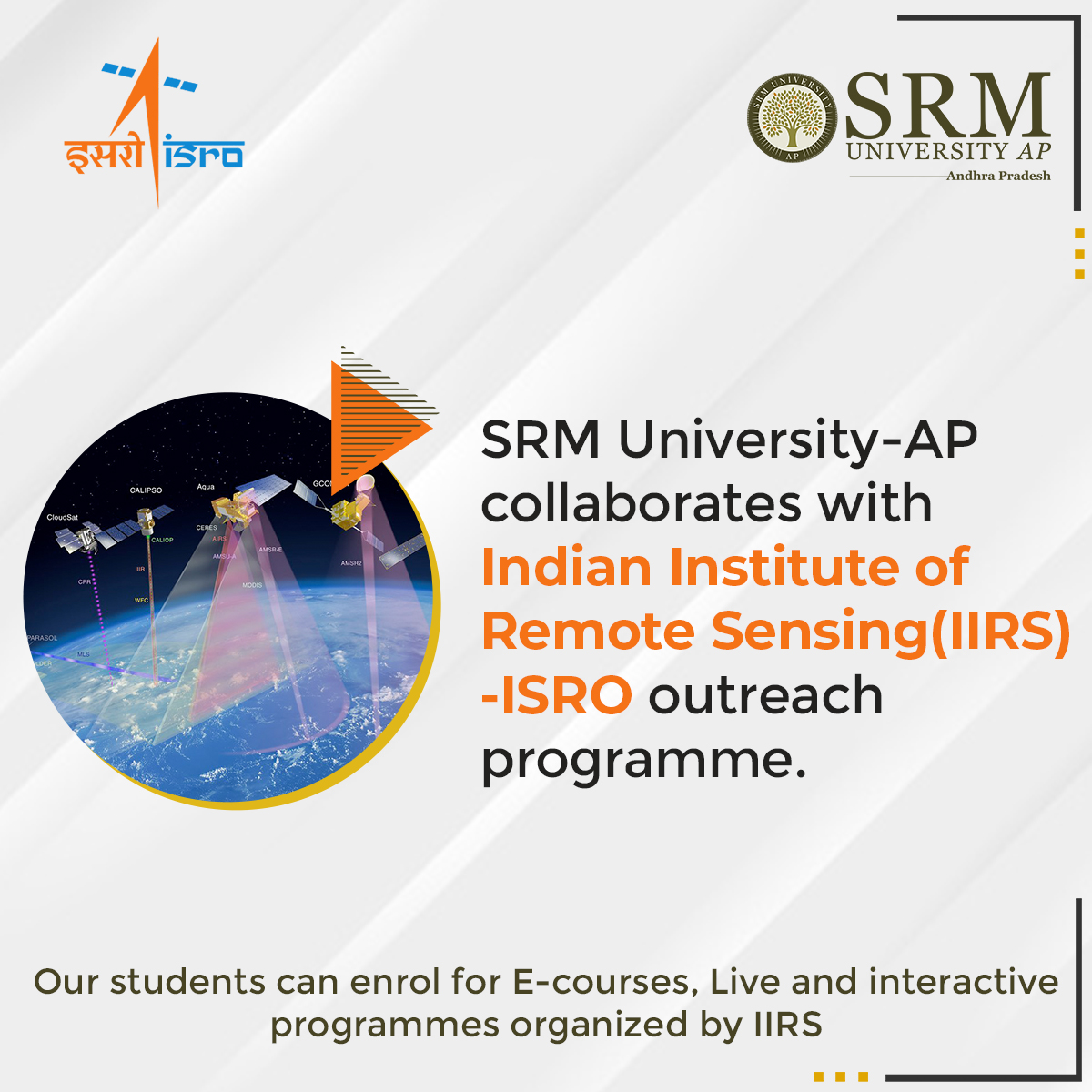Recent News
- SRM AP’s collaboration with IIRS-ISRO enable students to avail outreach programmes June 23, 2020
 SRM University AP-Andhra Pradesh has collaborated with the Indian Institute of Remote Sensing (IIRS) -Indian Space Research Organization (ISRO)’s outreach programme. SRM AP is included among the top-notch universities of India that can benefit from the incomparable Outreach Programme. As part of the association, the students of SRM AP will have the excellent opportunity to register for annual courses as well as live and interactive programmes being organized by IIRS. In addition, E-learning courses for a short span of 3-4 Month duration will be accessible by the students.
SRM University AP-Andhra Pradesh has collaborated with the Indian Institute of Remote Sensing (IIRS) -Indian Space Research Organization (ISRO)’s outreach programme. SRM AP is included among the top-notch universities of India that can benefit from the incomparable Outreach Programme. As part of the association, the students of SRM AP will have the excellent opportunity to register for annual courses as well as live and interactive programmes being organized by IIRS. In addition, E-learning courses for a short span of 3-4 Month duration will be accessible by the students. Please view the annual course calendar 2020 here
Please view the annual course calendar 2020 here ISRO is among the best-performing government organizations in India which has mastered the sophisticated space technologies, along with receiving applauds globally. The organization’s brilliant research and development, and applications for societal benefits like tele-education, telemedicine, disaster management, agriculture, fisheries and infrastructure development, ensures its dominance in the world. ISRO has launched the IIRS Outreach Programme to strengthen academia in terms of Space Technology & its applications through online learning platforms.
The popularity of remote sensing, geographical information system, global navigation satellite system and associated geospatial technologies in the current times require trained manpower in the domain. The students of SRM AP are encouraged to proactively avail the interactive distance learning courses and webinars that will enable the students to achieve their career goals in aerospace and geospatial technologies and make a mark globally.
Know more about Registration: https://elearning.iirs.gov.in/outreach.php
Register here: https://elearning.iirs.gov.in/Registration.php
 Click here to know more about the registration procedure
Click here to know more about the registration procedureFor additional information or clarification, please contact programme coordinator:
Prof. Siva Sankar Yellampalli
Continue reading →
Professor of Practice & Head of the Department,
Department of Electronics and Communication Engineering
E-mail: sivasankar.y@srmap.edu.in
Contact No: 7760280268 - Small-World Wireless Sensor Network to Help Making Smart Applications for Industries April 26, 2020
 Dr Om Jee Pandey, Assistant Professor, Department of Electronics and Communication Engineering, has recently published two papers in renowned IEEE journals. His paper “Secrecy Performance Analysis of Two-way Relay Non-Orthogonal Multiple Access Systems” was published in IEEE Access Journal, having an impact factor: 4.06. Whereas, “Fault-Resilient Distributed Detection and Estimation over an SW-WSN Using LCMV Beamforming” was published in IEEE Transactions in Network and Service Management (Impact factor: 4.682). The study was done in associations with Prof. Rajesh M Hegde, Department of Electrical Engineering, IIT Kanpur and Prof. Ha H. Nguyen, Department of Electrical and Computer Engineering, University of Saskatchewan, Saskatoon, Canada. His research was focused on developing efficient Wireless Sensor Network services in small-world models. The proposed research can be applied in developing many state-of-the-art applications in the areas related to healthcare systems, climate-smart agriculture, intelligent transportation, home automation, manufacturing, smart utilities, and industries etc.
Dr Om Jee Pandey, Assistant Professor, Department of Electronics and Communication Engineering, has recently published two papers in renowned IEEE journals. His paper “Secrecy Performance Analysis of Two-way Relay Non-Orthogonal Multiple Access Systems” was published in IEEE Access Journal, having an impact factor: 4.06. Whereas, “Fault-Resilient Distributed Detection and Estimation over an SW-WSN Using LCMV Beamforming” was published in IEEE Transactions in Network and Service Management (Impact factor: 4.682). The study was done in associations with Prof. Rajesh M Hegde, Department of Electrical Engineering, IIT Kanpur and Prof. Ha H. Nguyen, Department of Electrical and Computer Engineering, University of Saskatchewan, Saskatoon, Canada. His research was focused on developing efficient Wireless Sensor Network services in small-world models. The proposed research can be applied in developing many state-of-the-art applications in the areas related to healthcare systems, climate-smart agriculture, intelligent transportation, home automation, manufacturing, smart utilities, and industries etc.In order to develop efficient Wireless Sensor Network (WSN) services, several methods have been proposed for node localization, clustering of sensor nodes, new routing algorithms, adaptive duty cycles, usage of mixed-transmission models, placement of intelligent gateways, usage of mobile elements, and bypassing holes. However, the introduction of small-world characteristics in a WSN has hitherto not been used in this context. A small-world network is typically characterized by a low average path length and high average clustering coefficient and has been widely used to model social networks. However, small world models have not been used in the development of WSN. The primary objective of this research is to develop small world models for WSN services such as sensor node localization, data gathering, data fusion, network lifetime maximization, energy-balancing, reduced data transmission delay, time synchronization, energy-harvesting, and robust distributed detection and estimation. A small world WSN reduces the number of hops required for data transmission, and maximal utilization of sensor nodes closer to the sink. Other advantages of small world WSN include efficient bandwidth utilization, increased network lifetime, and fast convergence of event detection and parameter estimation. Small world WSN developed in tandem with novel routing strategies leads to improved WSN services for various applications.
In WSNs, sensor devices transfer the data cooperatively using multiple hops over a network. Multiple hops required for data transmission over a WSN leads to reduced network performance in the context of device localization, energy efficiency, energy balancing, data latency, speed of event detection and parameter estimation, and network robustness. This is because of poor distance estimation between sensor device pairs, maximum utilization of sensor devices closer to the sink, and a short radio range of sensor devices. Hence, the primary focus of this research work is to reduce the number of hops required for data transmission. In this context, Small World Characteristics (SWC) can be introduced in a WSN, leading to a small world WSN (SW-WSN). An SW-WSN is a well-connected network with reduced hop counts between node pairs.
Small world phenomena were first observed by Stanely Milgram in social connectivity of people. Later, it came out as a theory of “six degrees of separation”. Six degrees of separation claims that all people are six, or fewer, social connections away from each other. This theory is also known as the 6 Handshakes rule. Further, small-world phenomena have been investigated in graphs. Subsequently, SWC is observed in wireless networks. In general, small world WSNs (SW-WSNs) are characterized by low Average Path Length (APL) and high Average Clustering Coefficient (ACC). For an undirected WSN with N nodes, representing a regular network, the APL increases linearly with the number of nodes present in the network. On the other hand, in a WSN having SWC the APL, between two randomly selected nodes grows proportionally to the logarithm of the number of nodes in the network. “WSNs are spatial graphs, where links are created using radio connectivity. There is a limit on the radio range of a sensor node, hence in such networks, the long-range connections are generally absent. Thus, these networks are clustered, but they do not experience small-world phenomena. Hence, the primary focus of this work is to develop SW-WSN using various methods leading to efficient WSN services” explained Dr Pandey.
Dr Pandey is now busy to take the studies further. His future projects include-
Continue reading →
• Small World WSN (or SW-WSN) Development for Smart Healthcare.
• Cognitive SW-WSN for Energy-Efficient CPS and IoT applications.
• Climate Smart Agriculture using Cognitive SW Characteristics.
• Low-Latency and Intelligent Transportation over small world CPS.
• Multi Sensor Fusion over SW-WSN for CPS/IoT Applications.
• Information and Context Quality in WSN, IoT and CPS Networks.

